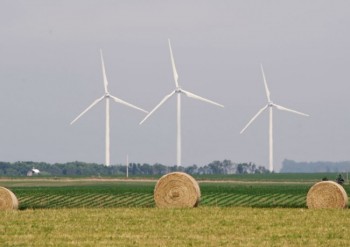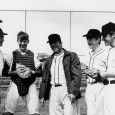The Gift of South Dakota
Subscriptions to South Dakota Magazine make great gifts!
Subscribe today — 1 year (6 issues) is just $29!
When the Feathers Hit the Fan
Jul 1, 2013
I confess that I have a somewhat pernicious sense of humor, something I apparently share with Mother Nature. The white-throated needletail has been spotted in Britain only eight times since 1846. I know nothing about this creature except that it is a bird with a white throat and rather sharp tail feathers.
Recently forty stalwart Limey bird watchers gathered in the Hebrides, a group of islands just off the coast of Scotland, to catch a glimpse of this rare avian survivor. They got one, but unfortunately the guest of honor didn’t survive. After two hours of ecstatic bird watching, the bird flew into a wind turbine and was flattened like a fly with a fly swatter.
There may be many morals to this story, but one is surely this: well-meaning plans often have unforeseen consequences. Wind turbines may be part of a smart energy package, though I have my doubts. What is beyond doubt is that they kill a lot of birds and bats. A study published in the Wildlife Society Bulletin estimates bird fatalities from wind turbines at 573,000 per year. That includes 88,000 raptors, which is worth mentioning only because raptors are really cool. I know I’d be a poorer man if I never saw an eagle fly. I am not sure what seeing an eagle fly into a wind blade would do to my balance sheet.
The carnage is considerably worse for bats. Wind turbines apparently knock about 888,000 of these winged mammals out of the air every year. I really like bats. They are basically mice that scoop the air with big webbed fingers. Some of them use sonar to hunt for creatures I am less fond of, like mosquitoes. Some years ago I set up camp in the Ozarks just as the sun was setting. We were suddenly swarmed by mosquitoes. Then the bats came out and in about a half hour they had scoured Sylamore Canyon clean of the pests.
I don’t know how many bats we can afford to sacrifice annually to these gleaming white pinwheels, especially since bat populations are suffering a dramatic population decline due to a pernicious fungus. Nearly a million seems like a significant cost.
It is not a cost the wind industry needs to worry about. According to the Associated Press, the Obama Administration has never fined or prosecuted a wind farm for killing eagles or other protected species. Instead, they have shielded the industry from any liability. This is not how they treat oil companies or power companies when birds drown in waste pits or fry on power lines. When a protected species hits the fan it is, in principle, a federal crime. The Administration has resolutely kept a blind eye.
You can decide for yourself whether wind power, which generates 3.5% of our electricity nationally, is worth the loss of fur and feathers. If you pretend to care about all about our airborne cousins, you might be concerned that President Obama wants to double “renewable” energy sources by 2020. If wind power expands to contribute 7% of our power, what will that mean for birds and bats?
It is possible that technological innovations will produce less lethal fans. No one seems knows how to do that. It’s also possible that, with more efficient turbines we can double the energy yield without quite doubling the number of blades. Still, a doubling of the energy yield will almost certainly mean more blades and that means that the dreadful numbers mentioned above will go up. A policy dedicated to expanding renewables will necessarily have to go on ignoring that.
President Obama has a great faith in the power of central planning. As Ron Bailey points out in Reason Magazine, his recent energy policy initiative amounts to a Soviet-style Five Year Plan, only with less than four years to go. We know how central planning works and we can see it in the Administration’s handling of the bird problem. When central planners decide to do one good thing, they usually commit to ignoring everything else.
The birds and the bats are not the only ones who will suffer from energy policies driven by pretty ideas. In his speech, the President praised Germany for “going all out in the race for clean energy.” One of the results of that all-out rush is that German households pay about three times as much for a month of power as their American counterparts. If you tell me that I have to chop falcons and bats into McNuggets in order to keep my house well lit at night and warm in the winter, I might reluctantly buy in. If you tell me I am going to kill those creatures so I can pay three times as much for electricity, I am opting out.
Editor's Note: Ken Blanchard is our political columnist from the right. For a left-wing perspective on politics, please look for columns by Cory Heidelberger every other Wednesday on this site.
Dr. Ken Blanchard is a professor of Political Science at Northern State University and writes for the Aberdeen American News and the blog South Dakota Politics.










Comments
Good post, Ken.
I still have not found an answer to the question of what happens to all these wind machines if, in the future, they become unusable for whatever reason. Are they to deteriorate where they stand? A junkyard of broken windmills? Is the state responsible to remove them? The landowner? The power company? Or nobody?